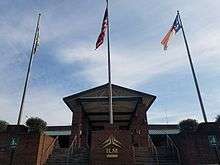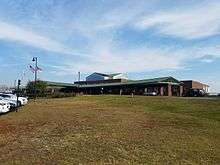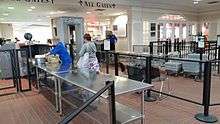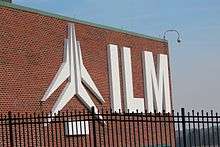Wilmington International Airport
| Wilmington International Airport New Hanover County International Airport | |||||||||||||||
|---|---|---|---|---|---|---|---|---|---|---|---|---|---|---|---|
 | |||||||||||||||
 | |||||||||||||||
| Summary | |||||||||||||||
| Airport type | Public | ||||||||||||||
| Owner | New Hanover County, North Carolina | ||||||||||||||
| Operator | Wilmington Airport Authority | ||||||||||||||
| Serves | Wilmington, North Carolina | ||||||||||||||
| Location | Wrightsboro, North Carolina | ||||||||||||||
| Elevation AMSL | 32 ft / 10 m | ||||||||||||||
| Coordinates | 34°16′14″N 077°54′09″W / 34.27056°N 77.90250°WCoordinates: 34°16′14″N 077°54′09″W / 34.27056°N 77.90250°W | ||||||||||||||
| Website | www.flyilm.com | ||||||||||||||
| Map | |||||||||||||||
 Wilmington International Airport | |||||||||||||||
| Runways | |||||||||||||||
| |||||||||||||||
| Statistics (2012) | |||||||||||||||
| |||||||||||||||
Wilmington International Airport (IATA: ILM, ICAO: KILM, FAA LID: ILM) is a public airport located just north of Wilmington, North Carolina, in unincorporated Wrightsboro, Cape Fear Township, New Hanover County.
As of the 2015 FAA Airfield Traffic Analysis (ATA), Wilmington International Airport is the third busiest airport in the state and number 8 busiest airport in the southern region of the United States.
The airport began in 1927 as Bluethenthal Field, named for aviator Arthur Bluethenthal, the first Wilmingtonian to be killed in World War I. In the 1950s the airport became known as the New Hanover County Airport. In 1988 the airport added "International" to become known as New Hanover County International Airport. On December 17, 1997 the New Hanover County Airport Authority changed the name to Wilmington International Airport.
In 2009, the airport served over 800,000 passengers. The airport has two runways and a single terminal which has eight gates. The airport is also home to three fixed-base operations (FBO's) which currently house over 100 private aircraft. There is also a 24-hour US Customs ramp for international flights wishing to stop at the airport. The separate terminal was built to serve the 3,200 international flights that land each year (private or charter). The airport's location on the coast, halfway between NYC and Miami, makes it a desirable and less busy entry point to the country. Aircraft seen at ILM are A319,MD 88,B717,B737, and the regionals CRJ2,7,9 and the E 170 and 190.
Wilmington International Airport is owned by New Hanover County, North Carolina. The airport is leased to the Wilmington Airport Authority for $1 per year and expires in 2019. The current airport manager is Jon Rosborough, elected in 2001.[4] The Wilmington Airport Authority has five board members: Chairman John D. Lennon, Vice chairman Dr. Charles R. Kays, Secretary Robert S. Rippy, Thomas C. Barber, and Dr. I. A. Roseman .[4]
History
The airport was named Bluethenthal Field on Memorial Day, May 30, 1928, in honor of Arthur Bluethenthal, a former All American football player and decorated World War I pilot who was the first North Carolinian to die in the war.[5][6][7][8]
During World War II, the airfield was used by the United States Army Air Forces Third Air Force for antisubmarine patrols and training.
Piedmont Airlines began commercial flights to Wilmington in February 1948, and used Wilmington as one of its initial crew bases. Its first route was between Wilmington and Cincinnati, Ohio, with stops in Pinehurst, Charlotte, Asheville, the Tri-Cities and Lexington.[9] Piedmont also operated flights from Wilmington to Roanoke and New Bern in its early years. USAir (now US Airways) acquired Piedmont in 1987 and maintains a presence at the airport today.[10]
In addition to flights to its main regional hub at Charlotte Douglas International Airport, US Airways introduced three daily flights between Wilmington and La Guardia Airport in New York City during the 2000s following lobbying from the Wilmington community; however, following US Airways' planned transfer of La Guardia slots to Delta Air Lines, there is speculation that these flights will cease.[11] US Airways also introduced nonstop service to Ronald Reagan Washington National Airport in March 2011.[12]
American Eagle began service between Wilmington and Chicago O'Hare International Airport in July 2011 after the airport authority offered two years of waived fees and marketing cost sharing. This route has also been actively sought by the local business community for its connections to the West Coast and to Asia.[13] The route was discontinued on April 2, 2012.
ILM was one of four airports along the East Coast which served as an emergency abort landing site for the Space Shuttle. Improvements in the orbiter's braking system reduced the previous 10,000-foot (3,000 m) runway requirement to 7,500 feet (2,300 m) enabling ILM's 8,016-foot (2,443 m) runway to serve the role.[14]
Airlines and destinations
As of 2016, ILM offers scheduled service to 5 destinations.
Passenger

| Airlines | Destinations |
|---|---|
| American Airlines | Charlotte |
| American Eagle | Charlotte, Philadelphia, New York–LaGuardia Seasonal: Washington–National |
| Delta Air Lines | Atlanta |
| Delta Connection | Atlanta Seasonal: New York–LaGuardia |

Cargo
| Airlines | Destinations |
|---|---|
| DHL Aviation operated by Ameriflight | Charlottesville |
| FedEx Feeder operated by Mountain Air Cargo | Greensboro |
| UPS Airlines operated by Martinaire | Raleigh/Durham |
Top destinations
| Rank` | City | Passengers | Airline |
|---|---|---|---|
| 1 | Charlotte, North Carolina | 229,000 | American |
| 2 | Atlanta, Georgia | 109,000 | Delta |
| 3 | Philadelphia, Pennsylvania | 44,000 | American |
| 4 | New York (LaGuardia), New York | 27,000 | American, Delta |
| 5 | Washington (National), DC | 2,000 | American |
Other operations
As of August 2011, Wilmington International Airport has 134 aircraft that are based at the Airport. There are 100 single engine aircraft, 27 multi-engine aircraft, 7 jet engine aircraft, and 3 helicopters[16]
For the period ending September 30, 2015, the airport had 129,807 operations, an average of 355 per day: 11% air carrier, 26% air taxi, 49% general aviation, and 14% military.
Charter services include Air Wilmington. Air Wilmington has its own dedicated building. There are also several private and public hangars. A new international customs station was completed in 2008.
Recent improvements

Wilmington International Airport is undergoing many improvements and additions to attract more business to the Airport and to improve the experience of passenger’s travels. The Airport has built a new terminal to be used by the United States Customs to process passengers from international flights. Wilmington International has also built a new Visual Approach Slope Indicator ILS for Runway 24. The Airport has recently upgraded its outdated ventilation system with a new, more efficient system in the main terminal.
In 2006, the FAA Airport Improvement Program awarded Wilmington International Airport $10,526,342. $3,000,000 was allocated to improve runway safety areas and $7,526,342 was allocated to expand the Airports apron area, rehabilitate Runway 6/24, and rehabilitate Taxiways B, C, and E. Runway 6/24 had not been rehabilitated in more than 30 years. Rehabilitation of Runway 17/35 was completed in 2014, and the project was honored with the Ray Brown Airport Pavement Award, which recognizes the highest-quality U.S. airfield pavement produced each year.[17]
Governance

Wilmington International Airport is owned by New Hanover County. In 1987, New Hanover County created the New Hanover County Airport Authority to assist the airport director in running the Airport. The Airport is leased to the Airport Authority from New Hanover County for $1 per year until the year 2019.
The current airport director is Jon W. Rosborough. He was elected by the board in 2001. The current Deputy Director is Julie A. Wilsey, the Finance Director is James P. Morton, and the Operations Director is Gary W. Broughton
The New Hanover County Airport Authority has five board members. The current board members are: Chairman John D. Lennon, Vice chairman Dr. Charles R. Kays, Secretary Robert S. Rippy, Thomas C. Barber, and Dr. I. A. Roseman
Superfund site
A 1,500-square-foot (140 m2) burn pit on the airport property was named a Superfund site on March 31, 1989.[18] The burn pit was built in 1968 and was used until 1979 for firefighter training missions. Jet fuel, gasoline, petroleum storage tank bottoms, fuel oil, kerosene, and sorbent materials from oil spill cleanups were burned in the pit. Up to 500 gallons of fuel and other chemicals were used during each firefighting training exercise. The firefighters in the training missions mainly used water to put out the fires, but carbon dioxide and other dry chemicals were also used.[18] The soil and groundwater was found to have multiple contaminants, including benzene, ethylbenzene, total xylene, 2-methylnaphthalene, phenanthrene, chloroform, 1,2-dichloroethane, and chromium.[18]
When the contamination of the site was discovered, about 500 people live within a mile of the Site. Approximately 6,300 people get their drinking water from public and private wells within three miles of the Site. However, the contamination does not affect current residential populations since the groundwater contamination plume does not extend more than 350 feet from the burn pit.
The site has finished environmental remediation, and the last five-year review for the site was completed in August 2013.[18] According to the EPA the site has been unlisted from the national priority list.[19]
Accidents and incidents
- On August 22, 1962, a Piedmont Airlines Martin 4-0-4 swerved off the runway at ILM during a training flight. All three occupants survived but the aircraft was written off.[20]
- On April 23, 1987, a Swearingen Metro II operating a cargo flight for Air-Lift Commuter suffered an engine failure on takeoff at ILM and crashed, killing both occupants.[21]
- On May 4, 1990, a GAF Nomad arriving from Raleigh-Durham crashed on approach to runway 34, killing both occupants.[22]
See also
References
- ↑ FAA Airport Master Record for ILM (Form 5010 PDF)
- ↑ Wilmington International Airport, official site
- ↑ http://www.flyilm.com/LinkClick.aspx?fileticket=SBCNocReLag%3d&tabid=67
- 1 2 http://www.flyilm.com/AboutILMAirport/GeneralInfo.aspx
- ↑ "Bluethenthal, Arthur "Bluey"". Jewsinsports.org. Retrieved December 22, 2010.
- ↑ "Home of Distinction: Family Treasure". Wrightsville Beach Magazine. January 2009. Retrieved December 22, 2010.
- ↑ Jewish sports legends: the International Jewish Hall of Fame. Brassey's. 2000. Retrieved December 22, 2010.
- ↑ Along the Cape Fear. Arcadia Publishing. 1998. Retrieved December 22, 2010.
- ↑ http://ncpedia.org/aviation/piedmont-airlines
- ↑ http://www.usairways.com/en-US/aboutus/pressroom/history/piedmont.html
- ↑ http://www.starnewsonline.com/article/20110526/ARTICLES/110519816?p=all&tc=pgall
- ↑ http://www.starnewsonline.com/article/20110113/ARTICLES/110119820?p=all&tc=pgall
- ↑ http://www.starnewsonline.com/article/20110314/ARTICLES/110319818?p=all&tc=pgall
- ↑ NASA Names North Carolina Airport Emergency Landing Site for Shuttle
- ↑ "RITA | BTS | Transtats". Bureau of Transportation Statistics. January 2017. Retrieved May 16, 2017.
- ↑ http://airnav.com/airport/KILM
- ↑ "S.T. Wooten Corp. Wins National Airport Paving Award". ForConstructionPros.com. AC Business Media. 2014-01-29. Retrieved 2015-02-02.
- 1 2 3 4 "New Hanover County Airport Burn Pit". US Environmental Protection Agency. Retrieved December 17, 2010.
- ↑ "Search Superfund Site Information". cumulis.epa.gov. EPA. Retrieved 20 April 2017.
- ↑ http://aviation-safety.net/database/record.php?id=19620822-0
- ↑ http://aviation-safety.net/database/record.php?id=19870423-1
- ↑ http://aviation-safety.net/database/record.php?id=19900504-1
-
 This article incorporates public domain material from the Air Force Historical Research Agency website http://www.afhra.af.mil/.
This article incorporates public domain material from the Air Force Historical Research Agency website http://www.afhra.af.mil/.
External links
- FlyILM
- "Wilmington International Airport – ILM" (PDF). at North Carolina DOT airport guide
- FAA Airport Diagram (PDF), effective August 17, 2017
- FAA Terminal Procedures for ILM, effective August 17, 2017
- Resources for this airport:
- AirNav airport information for KILM
- ASN accident history for ILM
- FlightAware airport information and live flight tracker
- NOAA/NWS latest weather observations
- SkyVector aeronautical chart for KILM
- FAA current ILM delay information
.jpg)